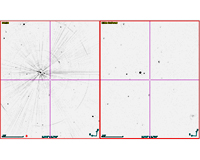New BETA image points to ASKAP imaging potential
15 May 2014 A new image produced by the ASKAP commissioning team using the 6-antenna ASKAP test array at the Murchison Radio-astronomy Observatory (MRO) has shown an excellent comparison to data from a previous all-sky survey, indicating the potential of the ASKAP imaging capabilities. The Boolardy Engineering Test Array (BETA) represents the first six ASKAP antennas installed with phased array feed (PAF) receivers and their associated digital systems, beamformer and hardware correlator at the MRO. Commissioning activities on BETA over recent months have produced the first continuum image across all 15 baselines of the array, and more recently, the first spectral line data cube, already being shared with the ASKAP Survey Science Teams for analysis. More recently, an initial exploration of the imaging capabilities of BETA by the commissioning team has produced an excellent comparison between ASKAP commissioning data and data taken from the all-sky Sydney University Molonglo Sky Survey (SUMSS). The ASKAP data was based on a single beam from a BETA PAF receiver, focused on calibration source PKS B0407-658. The resulting image is an excellent comparison to a cut-out section of the SUMSS data, with all main sources being clearly visible. The high sensitivity and dynamic range demonstrated in this data – while taken from just a single beam – bodes well for the imaging capability possible with the BETA system, and ultimately ASKAP. Back to Latest ASKAP News page. |
This loads a font easier to read for people with dyslexia.
This renders the document in high contrast mode.
This renders the document as white on black
This can help those with trouble processing rapid screen movements.

